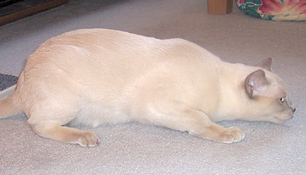
306
Vomiting is a protective reflex to expel toxins from the body, says Dr. Elissa Kadar. However, it can have very serious and detrimental effects. A cat vomits when the vomiting center in the brain receives input via the blood or nervous system and reacts to produce nausea followed by retching and the act of vomiting.
Dr. Kadar, a veterinarian with the Veterinary Medical Teaching Hospital of the University of California, Davis, at the School of Veterinary Medicine, advises that, in most cases, cats that vomit should be taken to the veterinarian. This especially applies to older and very young cats because their health can deteriorate more rapidly.
If a healthy cat vomits only occasionally, the causes may be minor, such as eating something out of the ordinary, bringing up hairballs or reacting to a medication. These instances may not require veterinary attention, she says.
However, she cautions that vomiting can be caused by a variety of disorders.
Older cats commonly vomit due to kidney disease, hyperthyroidism or cancer, but very rarely vomit due to parasites. On the other hand, young cats are more prone to eat toys or ribbons and very young kittens sometimes vomit due to worms. If in doubt, seek the attention of your veterinarian.
In general, the causes of vomiting can be divided into those occurring inside the gastrointestinal system and those occurring outside the gastrointestinal system.
Vomiting Versus Regurgitation
Certain behaviors can look like vomiting to owners, but actually have a completely different set of causes, says Dr. Kadar. Sometimes it seems obvious to you that your cat is vomiting, but it is very important for your veterinarian to decide if your cat is also regurgitating or coughing.
Regurgitation differs from vomiting in that no signs of nausea are noticed prior. [Specifically, no salivation, pacing or discomfort.] The action is passive, meaning the abdomen does not actively pump in and out as in vomiting. Regurgitation may occur right after eating or drinking and may contain undigested food or mucus. Sometimes the food may be shaped into a tubular form rather than a pool, as in vomiting. No bile or yellow staining is seen with regurgitation – if bile is present the cat is vomiting.
Dr. Kadar says regurgitation is generally caused by disorders of the esophagus such as inflammation, megaesophagus (a condition in which the esophagus becomes nonfunctional and distended), constrictions, or masses which cause obstructions.
Other disorders such as myasthenia gravis, or certain nervous system diseases can also result in regurgitation.
Once your veterinarian has determined that your cat is indeed vomiting, he or she will perform an examination and may either recommend tests to determine the cause or initiate symptomatic therapy.
Tests That Can Help Diagnosis
Blood and urine tests are generally a good starting point to try to look for causes of vomiting outside the gastrointestinal system, says Dr. Kadar. These tests will also help to determine if your cat is dehydrated and, if so, what kind of fluid therapy is necessary. Fecal examination for parasites and other infectious agents is warranted in many cases. In addition, your veterinarian may recommend X-rays to look for obstructions or foreign bodies in the gastrointestinal tract. If these tests are normal and your cat continues to vomit, further diagnostics may include an ultrasound of the abdomen, which allows the pancreas, liver and bowel to be assessed for changes in size, thickness or texture. Endoscopy and/or surgery enables your veterinarian to obtain tissue samples for biopsy and analysis. Certain types of foreign bodies your cat may have ingested can also be removed with endoscopy or surgery. Chest X-rays may also be necessary particularly if your cat is suspected of having cancer, a heart problem or aspiration pneumonia.
Therapy and Prevention
If your cat vomits once or twice but otherwise seems completely normal, Dr. Kadar suggests you can help by withholding food for 12 to 24 hours (unless you have a kitten, in which case it is not safe to withhold food for this long). Always have fresh water available, however. Then you can begin to feed small amounts of a bland diet – such as boiled white chicken meat – for a day or two and gradually switch back to the regular diet. If you decide to change your cats diet altogether, try to make any changes in diet gradually by mixing the old and new food together for several days before switching entirely to the new food.
If your cat continues to vomit, however, seek veterinary advice, she says. It is never safe to give human medications to cats unless under the guidance of your veterinarian, so never give in to the temptation. Other therapeutic options for vomiting cats depend on the cause of vomiting and your cats physical condition, says Dr. Kadar.
Your veterinarian may decide to send your cat home while waiting for blood test results, and recommend a change in diet or deworming if the problem has been going on for a while and your cat is otherwise stable. If the problem stems from a reaction to a medication, your veterinarian may adjust the dosage or prescribe an alternative medication. If your cat is dehydrated, he may require intravenous fluid therapy and other treatments while waiting for test results. If a cause outside the gastrointestinal tract is identified, specific therapy for the relevant disease will be recommended.
In terms of prevention, remember to keep strings and ribbons out of your cats reach, warns Dr. Kadar, because these can lodge under the tongue and then pass into the bowel, causing it to fold up like a concertina as the top of the string is anchored in the mouth. Provide safe toys that cannot be broken into pieces and ingested.


